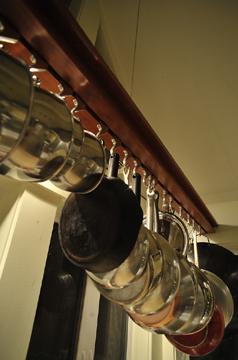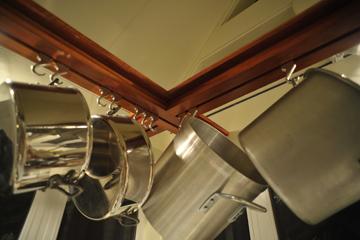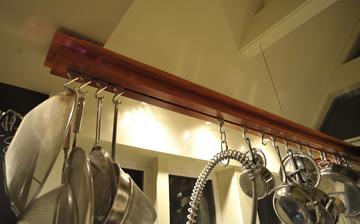
cbread
participating member-
Posts
279 -
Joined
-
Last visited
Content Type
Profiles
Forums
Store
Help Articles
Everything posted by cbread
-
I am curious about the correct amount of calcium hydroxide to add to water to keep veggies green and firm. I didn't see any quantities mentioned in that link above other than a "pinch". Not knowing how much water that they used, and suspecting calcium hydroxide may be very strong stuff, I am looking for guidance on correct proportions so I get enough but don't accidentally create a vegetable environmental superfund site.
-
"Modernist Cuisine" by Myhrvold, Young & Bilet (Part 2)
cbread replied to a topic in Cookbooks & References
Not so much a issue of getting their act together as an issue of demand exceeding supply on hand. The first printing is in various phases of production and transit and will get to amazon.ca whenever the gods of ships and customs and trucks decree. I too await my copy - ordered November. -
Wayyy at the bottom of this very long page mostly on nitamalization: http://www.cookingissues.com/2011/03/09/mesoamerican-miracle-megapost-tortillas-and-nixtamalization there is mention of uses of very small amounts of baking soda or calcium hydroxide to keep green veggies both green and firm in boiling water. What they indicate for quantities is a "pinch". Does anyone have any more exact proportion of cal to water?
-
Any chance that very useful looking app will ever be ported or written to run on a plain ol' desktop PC?
-
"Modernist Cuisine" by Myhrvold, Young & Bilet (Part 2)
cbread replied to a topic in Cookbooks & References
Mariani's is one more review that fails to recognize that new techniques and laboratory testing can serve simplicity and clarity. For me, the thing I most await in my none too soon to come copy of MC is a mass of tested data on how things actually work in the kitchen. I'll pass on exoticism for it's own sake and I cannot afford kilobuck gizmos, but what I do want is tested facts I can incorporate in day to day cooking. Mariani's stance seems self contradictory. He lauds McGee's book, but there is more in common than in fundamental difference between Myhrvold, McGee, and the staff at Cook's Illustrated's kitchen. They all investigate what's involved in making food better by actually doing research and cooking with a scientific "test the facts" mindset. -
Thanks very much to all for helping me get a better idea of what it is. Not sure I'm a good prospect for one since rather than aiming towards one pot meals, I'm more and more disassembling recipes into component parts and treating them each separately to optimize each component as best I can. Way more dishes to wash but my food has improved a great deal. It's not cheap. At the cost I see on those web pages, I could get a very good chamber vac or SV circulator. But price and my preferences aside, it appears very well made for one way of thinking about cooking. Were I to be making certain sauces and soups etc. in great quantity, I'd be thinking about one.
-
Thanks Chris for responding so quickly. Maybe I need to see one in action to understand?
-
Could someone help me grok what a Thermomix is. After reading some of the descriptive text about it in their page: http://www.vorwerk.com/thermomix/html/thermomix_tm31.html , I'm at a loss. "... TM 31 prepares dishes, also time-consuming, easier and faster than you are accustomed of the traditional cuisine. The several times patented all-in-one-concept of the Thermomix allows weighing, cutting, chaffing, kneading, stirring and heating - in one pot. Create tasty meals and even complete menus with the aid of one tool, do it without accessories. By the way: Thermomix TM 31 nearly cleans itself ..." The more I read, the less I understand. Why couldn't they show what it does, illustrate the mechanism, and demonstrate how it works? Were it not for the credibility of the folks at egullet who speak well of them, I'd pass it by as a complete scam or a joke. All manner of extravagant claims with no explanation whatsoever. How can any tool do all that without getting in one's way all the time? It sounds like a cookpot with a food processor, a scale, a stove and a servant spinning around in it. I'm wary of complex do-everything Swiss Army Knife-ey gadgets. They have a reputation for overpromising and underdelivering.
-
Hows about... Accuracy / precision. Rugged design and construction. Simplicity. Simple interface with minimal controls. Intuitive interface. Label all controls with words rather than icons one has to remember the meaning of. Display that reads out in words same as above. I'm wondering how simple and pared down a device could be without sacrificing ruggedness, easy operation and quality. Various timers and temperature probes, and data logging etc would be good but I believe some of those features may already be available in SVs from: www.fusionchef.us.
-
"Modernist Cuisine" by Myhrvold, Young & Bilet (Part 2)
cbread replied to a topic in Cookbooks & References
I realized just now that my friend who objected to the use of new kitchen technology sees sous vide and such as a kind of cheating that destroys the romance of cooking. The notion that good tools and techniques take away from the art, craft and existential goodness of cooking baffles me. What part of love and art is missing when someone cares enough to try to find a better way, or the best way to cook and works hard at making a deeply sensual experience even better? Cooking well is no less than love and art. I don't use a gram scale to cheat. I use it to make better food. -
"Modernist Cuisine" by Myhrvold, Young & Bilet (Part 2)
cbread replied to a topic in Cookbooks & References
I'll take a well done photo-shopped image over a poorly done painted picture, and a well painted painting over a sloppily photo-shopped photograph. It's the quality that matters. I'm an artist. A painter to be exact. But what I care about isn't the medium, it's whether the image works.In food, I care first and most about whether it's a good meal. Whether it's SVed and rotovapped - or - baked over a wood fire is only a descriptive and irrelevant story if the flavor doesn't work. -
"Modernist Cuisine" by Myhrvold, Young & Bilet (Part 2)
cbread replied to a topic in Cookbooks & References
The response to Modernist Cuisine has been "interesting". It and modern kitchen techniques in general seem to function as something of a litmus test for people's gut responses to modernism writ large. One friend of mine was almost hostile to the concept of souse vide cooking and said that the control SV offers takes away all the the art and craft. The concept of having process control rather than the magic of a chef's intuitive / experiential knowledge of when to take something off the grill bothered him greatly. I was greatly surprised since he's in the computer industry. I suspect that in other eras I would be reading the same negative responses about thermostatically controlled ovens, electric cook-tops, crock pot slow cookers etc. Every advance in control in one area allows the chef to attend to some other area in greater depth. The whole meal improves. Not having to fight with a piece of meat may let me make a better veggie. -
I put spices in square glass jars in a drawer. I label the tops so I can read what's what easily without having to fiddle with them. The square shape keeps them oriented so the labels are always readable and the shape is space efficient. Bought at www.sunburstbottle.com I got the SQ190 bottles. I've been happy with them. There seem to be a couple of heights available in the square shape.
-
I did the "Ideas" M&C as well as a tweeked "Modernist" M&C found here in egullet. Both very good. I suspect I will be combining ideas from both books. I really liked the directness of the "ideas" recipe. Edited for bad pselling
-
I use mostly yellow onions and have been very disappointed lately. I thought my local supermarket was once again cheaping out and buying low quality onions rather than paying the extra two cents to get good quality produce. Guess I was wrong. The only onion shopping criterion I know of is to select the cleanest, hardest, most perfect looking onions I can find and reject all others. Even then, I have lately brought home too many marginal onions and a couple of real stinkers. I stopped buying bagged anything - other than those veggies where bagged is the only choice. My market loves to use bulk size bags to get rid of their second quality items.
-
Another way to ruin a shelf safe boxed product is a supermarket employee cutting open corrugated boxes using a box cutter a little too aggressively. I had one box of chicken broth that turned out to have been sliced not quite through the full thickness of the container. Over time with a couple of handlings that flexed the damaged surface it lost it's integrity and gradually leaked onto a shelf in my pantry.
-
I assume quantities of carrageenan need to be precise. Can anyone with knowledge of the usage of carrageenan and citrate offer specifics on what proportionate quantities of iota carrageenan and sodium citrate are needed to make a batch of that or a similar mac n' cheese? When the pictures of that Mac n' cheese and the information on it hit these pages, I sourced iota carrageenan and sodium citrate in the hopes that my copy of MC would arrive soon. Now I find Amazon.ca is looking at a pushed back ship date in early April, and I need to make something like that mac n' cheese. My (probably lifetime) supply of carrageenan arrived today and citrate will soon follow. What I now lack is knowledge of how to put them to use.
-
Rural gas installations need not be unsightly. My propane tank is buried and only has a small dome above ground for the meter and for fill-ups. It's worthwhile to be ready to insist that the installation be un-intrusive. Around northern New England propane is common enough that screwed up stove calibration for gas have not been an issue for me. All that said, had I the need to redo my kitchen, I might consider a hybrid installation with four gas burners and one or two electric - probably induction. Had I to choose only one energy source, it would be gas, no question, not a moment's hesitation. One more vote for electric ovens here. Now that I have good beefy cookware with good conductivity all the way up the sides, I never get burnt sides on the pans. When I used cookware with thick bottom and thin sides, the burnt sides were frequent.
-
Neither corn chowder nor spaghetti carbonara work right without a strong dose of black pepper.
-
I don't think most people have any idea of just how very much more heat energy a slab of aluminum contains at any heat than the same mass slab of steel. The aluminum holds almost twice as much heat. It's not particularly intuitive. I would think that of all the posters on this thread, Scott might be the one most wanting to get hold of a big big aluminum slab. I think that's it for me here on this subject. I don't want to beat this dead horse any further. Best that actual tests determine what properties make the best of each style pizza.
-
The suggestion that a massive plate aluminum at 550F or similar will drop precipitously in temperature the moment the oven is opened is erroneous. Aluminum has a very high heat capacity when used in similar mass to iron and steel. I'm too slow a typist to do justice to the physics of common cooking materials and heat so I won't try. All that has been well explained here and elsewhere many a time. Good references are: http://www.cookingforengineers.com/article/120/Common-Materials-of-Cookware Here's a non technical way to look at it. Put a really thick aluminum pan on the stove on high and you will find it takes a long time to heat to the temperature you need. It absorbs much heat energy and only gradually attains high temperature. Some folks really don't like truly massive aluminum pans because they take a long time to heat up. Think of big slabs of aluminum as particularly effective storage places for heat when compared with similar masses of steel or iron. The same happens in reverse. Once the pan has got to a high temperature, turn off the heat and that massive aluminum pan stays hot enough to cook for a surprisingly long time. Try it by turning it off and tossing in some food. You'll be able to do quite a bit of cooking before the pan is ineffectual. The heat can leak out of the pan only so fast. The reason it stays hot enough to cook is the same reason a massive pizza slab in the oven will. Materials can only lose heat as fast as combined actions of radiation, conduction and convection will allow. Those are the only mechanisms by which the slab or the pan can lose heat. They happen for steel and aluminum in pretty much the same way. Aluminum's very high conductivity evens out the temperature of the pan or slab better than most materials, but it does not miraculously jet heat out of the surface in ways not allowed by the laws of physics. A pound of aluminum takes more energy to heat to a given temperature than a pound of cast iron. Takes longer to heat and takes longer to cool. There's no miracle that will suddenly suck all that heat energy out.
-
Things from the professional kitchen that every home cook should have
cbread replied to a topic in Kitchen Consumer
Could there please be photos of the above posts. Thanks. Sorry I missed that way back then... Just stumbled upon the request and have added photos. -
If you are cooking at home, mild steel - also refered to as non-stainless steel - is fine. As is thick aluminum plate. Mild steel will be by far the least expensive.I'm guessing your fabricator is unwilling to vouch for materials that are not approved for restaurant usage. Keep in mind that a cast iron pan is basically elemental iron and carbon. Mild steel is elemental iron and carbon. Slightly different ratios, but it is for the purposes of food safety a distinction without a difference. The contaminants idea is pretty much bogus, but in out litigious society businesses have to take liabilities real and imagined into account when they talk to the public. I'm sure that one could theoretically add contaminants to any pizza stone, but in the real world the same real cleaning you would give any new kitchen item will take care of the usual dirt and gunk that transportation, packing, handling etc entail.
-
I have been wondering what distinguishes dry-brining from salting early?



